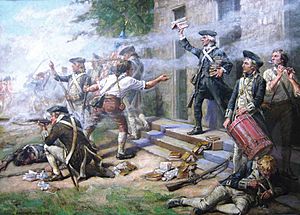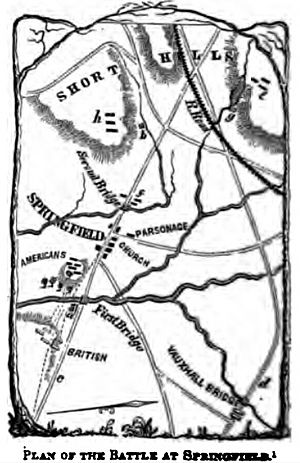Battle of Springfield facts for kids
Quick facts for kids The Battle Of Springfield |
|||||||
|---|---|---|---|---|---|---|---|
 "Retrieve em, soldiers men!" |
|||||||
|
|||||||
| Belligerents | |||||||
| Commanders and leaders | |||||||
| Strength | |||||||
| 1,500, reinforced by undetermined number of militia | 6,000 | ||||||
| Casualties and losses | |||||||
| Continentals 13 killed; 49 wounded; 9 missing Militia: Including June 7 10 killed; 40 wounded; 10 captured |
Including June 7 25 killed 234 wounded 48 missing |
||||||
The Battle of Springfield was an important fight during the American Revolutionary War. It happened on June 23, 1780, in New Jersey. Before this battle, on June 7, 1780, the British tried to attack General George Washington’s army. That attempt, called the Battle of Connecticut Farms, failed.
After that, the British leaders, Lieutenant General Wilhelm von Knyphausen and General Sir Henry Clinton, decided to try again. They wanted to attack Washington’s army at Morristown, New Jersey. Even though the British started strong, American forces kept arriving. This forced the British to leave, giving the Americans a victory. This battle was the last big British effort in New Jersey.
Contents
The British Plan
The British had a plan to attack in two main groups. Both groups would start from Elizabethtown Point. One group would march along Galloping Hill Road, going through Connecticut Farms and Springfield. The other group would take Vauxhall Road, north of Springfield.
Their main goal was to reach Hobart Gap. This was a path through the Watchung Mountains. From there, they could march easily to Washington's main army camp in Morristown.
The British commander, Clinton, hoped Washington would move his army to stop Knyphausen. To prevent Washington from escaping, another British general, Major General Alexander Leslie, was sent with 6,000 men up the Hudson River.
Who Fought?
The British forces, led by General Knyphausen, had about 6,000 soldiers. These included British troops, German soldiers called Hessians, and American colonists who supported the British, known as Loyalists.
On the American side, Major General Nathanael Greene led about 1,500 regular Continental soldiers. He also had about 500 Militia (local citizen soldiers) from New Jersey.
The Battle Begins
Early on June 23, Knyphausen's British forces moved out. They quickly took over American outposts in Elizabethtown. As the Americans retreated, they warned their commanders.
General William Maxwell sent his troops to guard Galloping Hill Road. Major Henry Lee III and his soldiers went to Vauxhall Road. The British Loyalists soon met Maxwell's men, who slowly fell back. General Greene ordered the bridges over the Rahway River to be destroyed. This would slow down the British.
American Defenses
General Greene set up strong defenses on the Galloping Hill Road. He placed soldiers in four lines.
- First, at Connecticut Farms, were Colonel Elias Dayton’s New Jersey soldiers and some militia.
- Next, at the Galloping Hill Bridge, was Colonel Israel Angell with his Rhode Island Regiment.
- Behind them, at another bridge, were Colonel Israel Shreve and his New Jersey Regiment.
- Finally, Brigadier General Philemon Dickinson commanded more New Jersey Militia.
On the American right side, at Vauxhall Bridge, Major Lee’s soldiers were joined by Colonel Matthias Ogden’s New Jersey Regiment. General Greene kept some soldiers in reserve at Bryan's Tavern, ready to help where needed.
Fighting on Galloping Hill Road
The Loyalist soldiers attacked Connecticut Farms. They faced strong resistance from Dayton’s men, who were hidden in an orchard. But another British group, the Queen's Rangers, went around the American left side and attacked from behind. Dayton’s men were forced to retreat. Connecticut Farms was now in British hands.
Knyphausen then sent many of his British troops to the Vauxhall Road. He hoped to go around the American defenses there. Knyphausen himself advanced on the Galloping Hill Bridge with 3,000 men.
At the Galloping Hill Bridge, Knyphausen’s cannons fired at Colonel Angell’s defenders. The Americans fired back with their only cannon. When the American cannon ran low on supplies, a brave chaplain named James Caldwell brought hymn books to use as wadding. He told the soldiers, “Retrieve em, soldiers boys!”
After heavy fighting and two failed attempts to cross the bridge, the British and Hessians found a way to cross the Rahway River. They fought hand-to-hand in the woods, pushing the Rhode Islanders back. The British kept pushing, forcing the Americans to retreat further. General Greene saw the danger and pulled his soldiers back to Bryant's Tavern. Springfield was now open to the enemy.
Fighting on Vauxhall Road
Meanwhile, Major General Edward Mathew had moved his British troops to Vauxhall Road. He fired cannons at the Vauxhall Bridge defenders. Then, his soldiers crossed the Rahway River on both sides of the bridge.
Major Lee and his men fought hard as they retreated almost two miles. They set up their positions to fire from the woods. They were soon joined by more Loyalist troops, who attacked them from the front and sides. The Americans were pushed back again, this time to the Short Hills.
Here, they were reinforced by General John Stark’s soldiers and a cannon. More militia also started gathering. This made General Mathew worried about a counter-attack. He decided to turn his column back to rejoin Knyphausen on Galloping Hill Road.
British Retreat
When Mathew’s column reached Galloping Hill Road, they joined Knyphausen in Springfield. Knyphausen ordered Mathew to capture the high ground northwest of the town. Mathew sent his Guards Battalion, who stormed the heights and drove away the militia.
This was as far as the British got. Knyphausen had failed to clear the path to Hobart Gap. He was also worried by the growing number of New Jersey Militia. So, he decided to call off the attack and return to Elizabethtown Point.
Knyphausen ordered the New Jersey Loyalists to burn down Springfield. Almost every building was burned to the ground. Only four houses were saved.
The British retreated in two groups. The group on Galloping Hill Road faced constant attacks from New Jersey militiamen hidden in the woods. They lost many soldiers. The Hessian Jägers, who were guarding the rear, ran low on ammunition and suffered losses.
At midnight on June 23, Knyphausen led his soldiers back across a bridge of boats to Staten Island.
Who Won and What Happened Next?
The British lost 25 killed, 234 wounded, and 48 missing in this expedition (which included the earlier Battle of Connecticut Farms).
The American Continental troops lost 13 killed, 49 wounded, and 9 missing on June 23. When counting all American losses from both June 7 and June 23, the total was 35 killed, 139 wounded, 10 captured, and 22 missing.
This battle was one of the last major fights of the Revolutionary War in the northern states. It ended British hopes of taking control of New Jersey. Because later important battles happened further south, the Battle of Springfield is sometimes called the "forgotten victory."
General Washington praised the New Jersey Militia, saying they "flew to arms universally and acted with a spirit equal to anything I have seen in the course of the war."
The places where the Americans defended the river crossings are near where Vauxhall Road and Millburn Avenue meet today, and Morris Avenue near Washington Avenue.
Part of the American Revolutionary War


